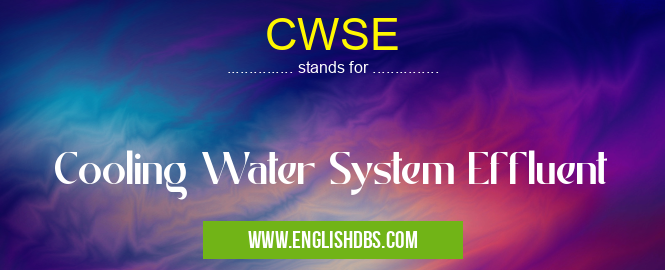What does CWSE mean in UNCLASSIFIED
CWSE stands for Cooling Water System Effluent. It refers to the water discharged from a cooling water system after it has been used to cool industrial equipment or processes. This effluent may contain various contaminants and pollutants, such as heat, chemicals, and suspended solids.

CWSE meaning in Unclassified in Miscellaneous
CWSE mostly used in an acronym Unclassified in Category Miscellaneous that means Cooling Water System Effluent
Shorthand: CWSE,
Full Form: Cooling Water System Effluent
For more information of "Cooling Water System Effluent", see the section below.
What is CWSE?
CWSE is generated in various industries, including power plants, manufacturing facilities, and data centers. These systems use water to absorb heat from machinery or industrial processes. The heated water is then discharged as CWSE, which must be treated or disposed of in an environmentally responsible manner.
Composition of CWSE
CWSE typically contains the following components:
- Heat: CWSE is typically discharged at elevated temperatures, which can have adverse effects on aquatic ecosystems.
- Chemicals: Cooling water systems may use various chemical additives, such as corrosion inhibitors and biocides, which can be present in CWSE.
- Suspended Solids: CWSE may contain suspended solids, such as dirt, scale, and other particles.
Environmental Impacts of CWSE
The discharge of untreated CWSE can have significant environmental impacts, including:
- Thermal pollution: Elevated temperatures can harm aquatic organisms and disrupt ecosystems.
- Chemical contamination: Chemicals in CWSE can be toxic to aquatic life and may bioaccumulate in the food chain.
- Physical impacts: Suspended solids can cause turbidity, smother fish eggs, and damage aquatic habitats.
Treatment of CWSE
To mitigate the environmental impacts of CWSE, it must be treated before being discharged into the environment. Common treatment methods include:
- Cooling Towers: Cooling towers dissipate heat from the water, lowering its temperature before discharge.
- Evaporation Ponds: Evaporation ponds allow water to evaporate, reducing its volume and concentrating pollutants.
- Chemical Treatment: Chemical precipitation and ion exchange can remove contaminants from CWSE.
Essential Questions and Answers on Cooling Water System Effluent in "MISCELLANEOUS»UNFILED"
What is CWSE?
Cooling Water System Effluent (CWSE) refers to the wastewater discharged from cooling water systems, typically used in power plants and industrial processes. These systems utilize water to cool down equipment and machinery, resulting in the generation of CWSE.
What are the main characteristics of CWSE?
CWSE is typically characterized by elevated temperatures, dissolved solids, and the presence of various chemicals and pollutants, including heavy metals, biocides, and corrosion inhibitors. The specific composition of CWSE can vary depending on the industry and the cooling system design.
How is CWSE managed?
CWSE management involves treating and disposing of the effluent in an environmentally responsible manner. Treatment methods can include physical, chemical, and biological processes to remove pollutants and reduce the environmental impact. Proper management practices aim to minimize the discharge of harmful substances into water bodies.
What are the regulatory requirements for CWSE discharge?
CWSE discharge is subject to various regulations and guidelines set by environmental authorities. These regulations establish limits on the concentration of pollutants, temperature, and other parameters to ensure compliance with water quality standards. Adherence to these regulations is crucial for protecting aquatic ecosystems and human health.
What are the potential environmental impacts of CWSE?
Untreated CWSE can pose significant environmental risks if discharged directly into water bodies. Elevated temperatures can harm aquatic organisms, while dissolved pollutants can accumulate in the environment and cause long-term ecological damage. Additionally, CWSE may contain pathogens or harmful substances that can impact human health through contact or consumption of contaminated water.
What are the best practices for minimizing the environmental impact of CWSE?
Best practices for minimizing the environmental impact of CWSE include implementing efficient cooling systems, reducing water consumption, employing effective treatment technologies, and adhering to regulatory requirements. By implementing these strategies, industries can significantly reduce the discharge of pollutants and protect water resources.
Final Words: CWSE is an important consideration for industries that use cooling water systems. Proper management and treatment of CWSE are essential to protect aquatic ecosystems and mitigate environmental impacts. By understanding the composition, environmental concerns, and treatment methods associated with CWSE, industries can make informed decisions to minimize their environmental footprint.
